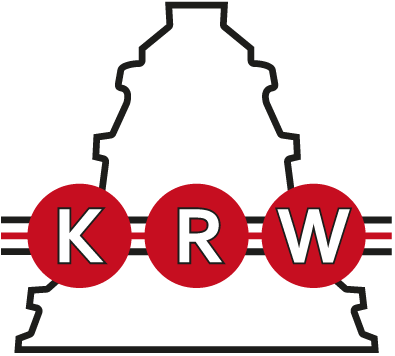
Tapered Roller Bearings
single row, metric
- Absorption of high axial and radial forces
- Assembly by pairs
- Reaches high rigidities when preloaded

Single row tapered roller bearings feature angular raceways of inner and outer ring and a resulting force-transferring contact angle. Due to this, an axial load always induces a radial load and the other way around, which is why tapered roller bearings are always combined with a second bearing. Paired, they can in addition to radial forces also absorb axial and combined forces and are particularly suitable for medium to high speeds. Single row tapered roller bearings can be disassembled which facilitates a separate assembly of inner and outer ring.
Dimensions and Tolerances
KRW supplies single row tapered roller bearings with normal tolerance (PN) in accordance to DIN 620-2 (Tolerances for roller bearings) and ISO 492 (Radial bearings - Dimensional and geometrical tolerances). All other deviating or special tolerances must be specified with the order.
Standards
The general dimensions of the single row tapered roller bearings are standardised by ISO 355 (Tapered roller bearings - Boundary dimensions and series designations) and DIN 720 (Rolling Bearings - Tapered roller bearings). Inch bearings conform to ANSI/ABMA Standard 19.2 (Tapered Roller Bearings - Radial Inch Design).
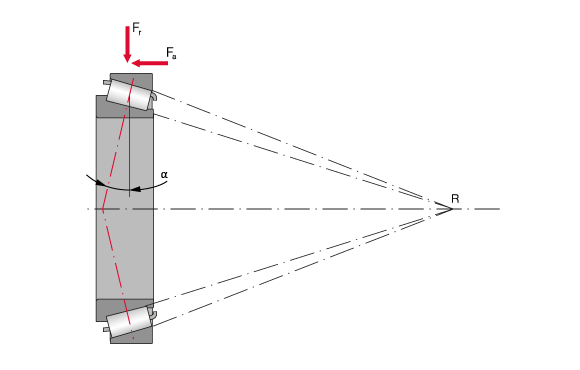
General structure of a tapered roller bearing, R = tip of roller taper
Bearing Design
Single row tapered roller bearings are separable and non-latching bearings. In addition to high radial forces, they can absorb single-sided axial forces as well as, in combination with a second mirror-image arranged tapered roller bearing, two-sided axial forces.
For combined bearing sets there is a distinction between O-, X-, or tandem arrangement based on pressure line contact. Bearing sets in O-arrangement are very rigid and are excellently suitable for the absorption of moments thanks to their wide support base. The mirror-image X-arrangement is usually used with an additional radial bearing functioning as floating bearing on the opposite end of the shaft. Bearings in tandem arrangement distribute the loads and increase the load capacity. In practice, this option is used very rarely.
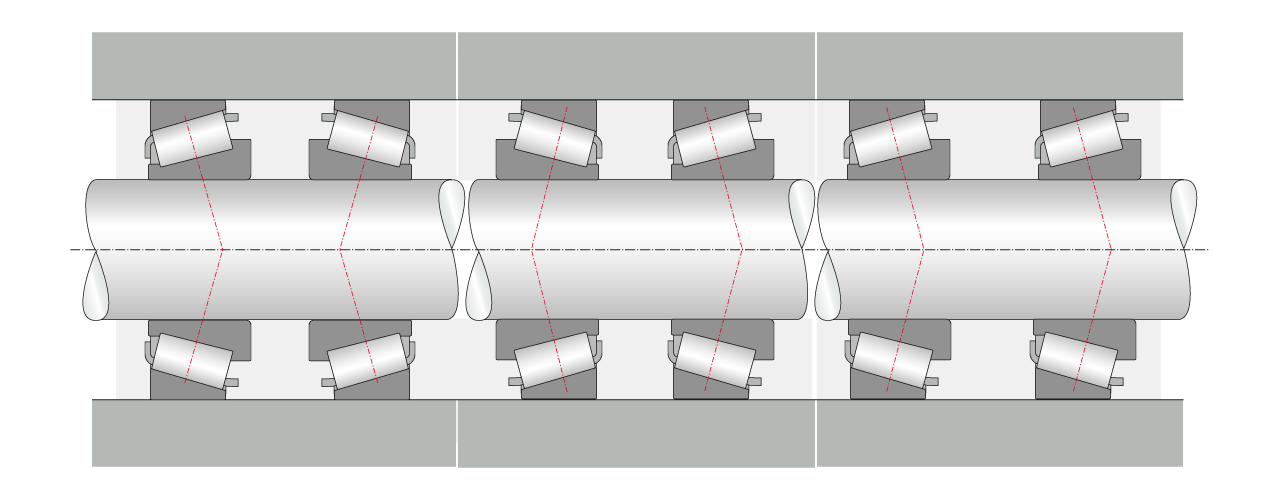
X-, O-, and tandem arrangement for tapered roller bearings
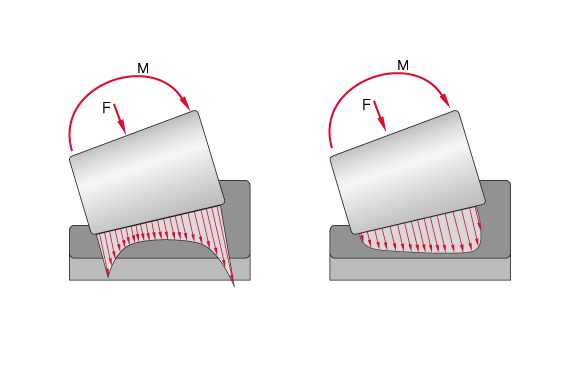
Roller profiling and tension distribution of tapered rollers in comparison. Left without profiling, right with profiling
By default, tapered roller bearings by KRW are designed with optimised contact areas between rolling elements and raceways. Due to the logarithmic profiling of the tapered rollers, damaging edge tension is avoided even with very high loads. The axial load capacity of a tapered roller bearing increases with higher contact angle.
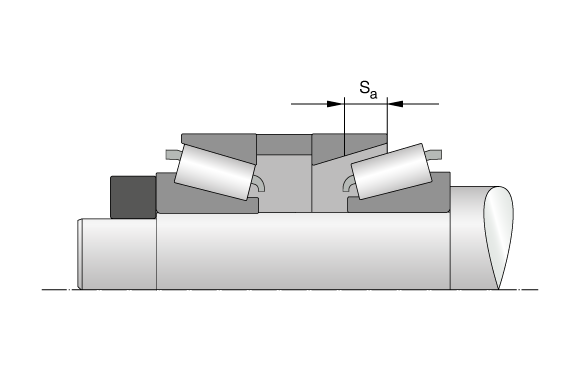
Bearing Clearance
The operating clearance or pre-stress of a tapered roller bearing adjusts with the positioning against a mirror-image arranged second tapered roller bearing after assembly.
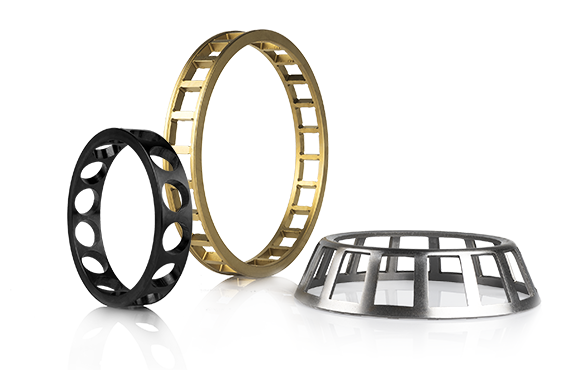
Cage
By default, single row tapered roller bearings by KRW are equipped with a flange riding solid brass window-type cage (suffix: MP) or a rolling element riding steel plate cage. Other cage designs are available on request or chosen for specific applications and labelled accordingly on the bearing.
Special Suffixes
| A | Modified internal design |
| B | Modified internal design, contact angle 20° |
| X | Bearings with boundary dimensions adapted to ISO standards |
Compensation of Angular Misalignments
Single row tapered roller bearings are of limited suitability for compensation of misalignments. The admissible misalignment between inner and outer ring depends on the bearing size, the internal bearing design, the clearance fit, and the acting of forces and moments. Misalignments cause harmful movement of the rolling elements and produce additional stresses in the bearing which reduce its operating life.
Speed
KRW distinguishes between kinematic limiting speed nG and thermal reference speed nth. The kinematic limiting speed is a practical mechanical limit value and is based on the mechanical fatigue strength of the rolling bearing as a function of its installation situation and lubrication. The limit speed must not be exceeded even under optimum operating conditions without prior consultation with KRW.
The thermal reference speed represents the equilibrium between the heat generated in the bearing by friction and the heat flow dissipated. It is standardised in DIN ISO 15312 (Rolling bearings - Thermal reference speed).
Admissible Operating Temperatures
The admissible operating temperature of a bearing is limited by cage material, dimensional stability of the bearing components (ball race and rolling elements), as well as lubrication. By default, KRW bearings are stabilised up to 200°C (S1). KRW provides roller bearings for higher operating temperatures on request.
Dimensioning
For dynamically loaded bearings
The service life formula according to ISO 281 L10 = (C/P)p for dynamically loaded bearings requires an equivalent load (P) from constant direction and size. To calculate P, calculation factors and the ratio of axial and radial load are required.
Equivalent Dynamic Bearing Load P
a) Single bearings and tandem arrangement

| P | equivalent dynamic load | [kN] |
| Fr | dynamic radial force | [kN] |
| Fa | dynamic axial force | [kN] |
| e | calculation factor, see chart | [-] |
| Y | calculation factor, see chart | [-] |
b) O- and X-arrangement
The equivalent bearing service life for the tapered roller bearings depends on the ratio Fa/Fr . The equivalent dynamic bearing load can be determined using the following formula:

| P | equivalent dynamic load | [kN] |
| Fr | dynamic radial force | [kN] |
| Fa | dynamic axial force | [kN] |
| e | calculation factor, see chart | [-] |
| Y | calculation factor, see chart | [-] |
Resulting axial force for O- and X-arranged roller bearings
Due to the angular raceways, when a radial force occurs, tapered roller bearings generate an axial reactive force which is relevant to the bearing dimensioning. When a shaft is supported by two identical or differently sized tapered roller bearings, the radial load of one bearing produces an axial load for the other bearing. This internal resulting force must be considered when determining the total axial load. The value of the total axial load on a single bearing is determined with the following formulas:

| Case | Load ratio | outer force | resulting axial force Fa | |
| bearing A | bearing B | |||
| 1 | FrA / YA ≤ FrB / YB | Ka ≥ 0 | Fa = Ka + 0,47 ∙ FrB / YB | Fa is not considered in the calculation |
| 2 | FrA / YA > FrB / YB | Ka > 0,47 · ( FrA / Ya - FrB / YB ) | Fa = Ka + 0,47 ∙ FrB / YB | Fa is not considered in the calculation |
| 3 | FrA / YA > FrB / YB | Ka ≤ 0,47 ∙ ( FrA /YA - FrB /YB ) | Fa is not considered in the calculation | Fa = 0,47 ∙ FrA / YA - Ka |
To the formulas applies that the bearings being affected by the outer axial force are marked with A and the counter bearings with B. All bearings are backlash-free and considered without pre-stress.
| FrA | radial force in bearing A | [kN] |
| FrB | radial force in bearing B | [kN] |
| YA | calculation factor for bearing A (see chart X- and O-arrangement) | [-] |
| YB | calculation factor for bearing B (see chart X- and O-arrangement) | [-] |
| Ka | outer axial force | [kN] |
| Fa | resulting axial force | [kN] |

c) Reduction of dynamic load rating in a bearing set
For identical tapered roller bearings assembled directly side by side in X-, O-, or tandem arrangement, the load rating of the bearing set must be reduced arithmetically. For the dynamic load rating, the following correlation applies:

| Cr | dynamic load rating of the bearing set | [kN] |
| Cr, single bearing | dynamic load rating of the single bearing | [kN] |
| i | number of identical bearings in bearing set | [-] |
For statically loaded bearings
Dynamic dimensioning loses its validity for bearings rotating at very low speeds (n x dm ≤ 4000 mm/min). The static load safety factor S0 is calculated as follows:

| S0 | static load safety factor | [-] |
| C0 | static load rating (from bearing chart) | [kN] |
| P0 | equivalent static bearing load | [kN] |
| n | speed | [min-1] |
| dm | mean bearing diameter [dm = (D+d)/2] | [mm] |
Static load capacity
a) Single bearings and tandem arrangement
For statically loaded single row or tandem arranged tapered roller bearings, the following correlations apply:

| F0r | max. radial static force | [kN] |
| F0a | max. axial static force | [kN] |
| Y0 | calculation factor, see bearing chart | [-] |
b) O- and X-arrangement
For statically loaded tapered roller bearings in X- or O-arrangement, the following correlations apply:

| F0r | max. radial static force | [kN] |
| F0a | max. axial static force | [kN] |
| Y0 | calculation factor, see bearing chart | [-] |
c) Reduction of static load rating in a bearing set
For identical tapered roller bearings assembled directly side by side in X-, O-, or tandem arrangement, the load rating of the bearing set must be calculated. For the static load rating, the following correlation applies:

| C0 | static load rating of the bearing set | [kN] |
| C0, single bearing | static load rating of the single bearing | [kN] |
| i | number of identical bearings in bearing set | [-] |
Minimum Radial Load
A minimum load is required for the reliable operation of a rolling bearing. If the minimum load is not reached, slippage may occur. The minimum radial load for tapered roller bearings is roughly assumed to be 2% of the static load rating C0 of the bearing. If the value falls below this value, please consult KRW Application Technology.
